First Published: 2024-02-23
Americas Headquarters
Cisco Systems, Inc.
170 West Tasman Drive
San Jose, CA 95134-1706
USA
http://www.cisco.com
Tel: 408 526-4000
800 553-NETS (6387)
Fax: 408 527-0883
New and Changed Information
The following table provides an overview of the significant changes up to the current release. The table does not provide an exhaustive list of all changes or the new features up to this release.
| Feature | Description | Release | Where Documented |
|---|---|---|---|
|
View active ans susceptible bugs |
In the Firmware Summary area, you can now hover on the Node Target Firmware and click View Bugs to view the active and susceptible bugs for that particular software version on that site. |
6.4.1 |
This document is available from your Nexus Dashboard Insights GUI as well as online at www.cisco.com. For the latest version of this document, visit Cisco Nexus Dashboard Insights Documentation.
Software Management
Software Management
Before performing an upgrade there are multiple validations that need to be performed. Similarly after an upgrade process, multiple checks helps to determine the changes and the success of the upgrade procedure.
The Software Management feature suggests an upgrade path to a recommended software version and determines the potential impact of upgrade impact. It also helps with the pre-upgrade and post-upgrade validation checks.
The Software Management feature offers the following benefits:
-
Assists in preparing and validating a successful upgrade of the network.
-
Provides visibility on the pre-upgrade checks.
-
Provides visibility on the post-upgrade checks and the status after the upgrade.
-
Minimizes the impact to the production environment.
-
Provides visibility if the upgrade process is a single step or multiple steps.
-
Displays the bugs applicable to a specific firmware version.
Guidelines and Limitations
Before running a post-upgrade analysis, ensure that all the nodes are already upgraded.
View Software Management Jobs
-
Navigate to Manage > Site Software Management.
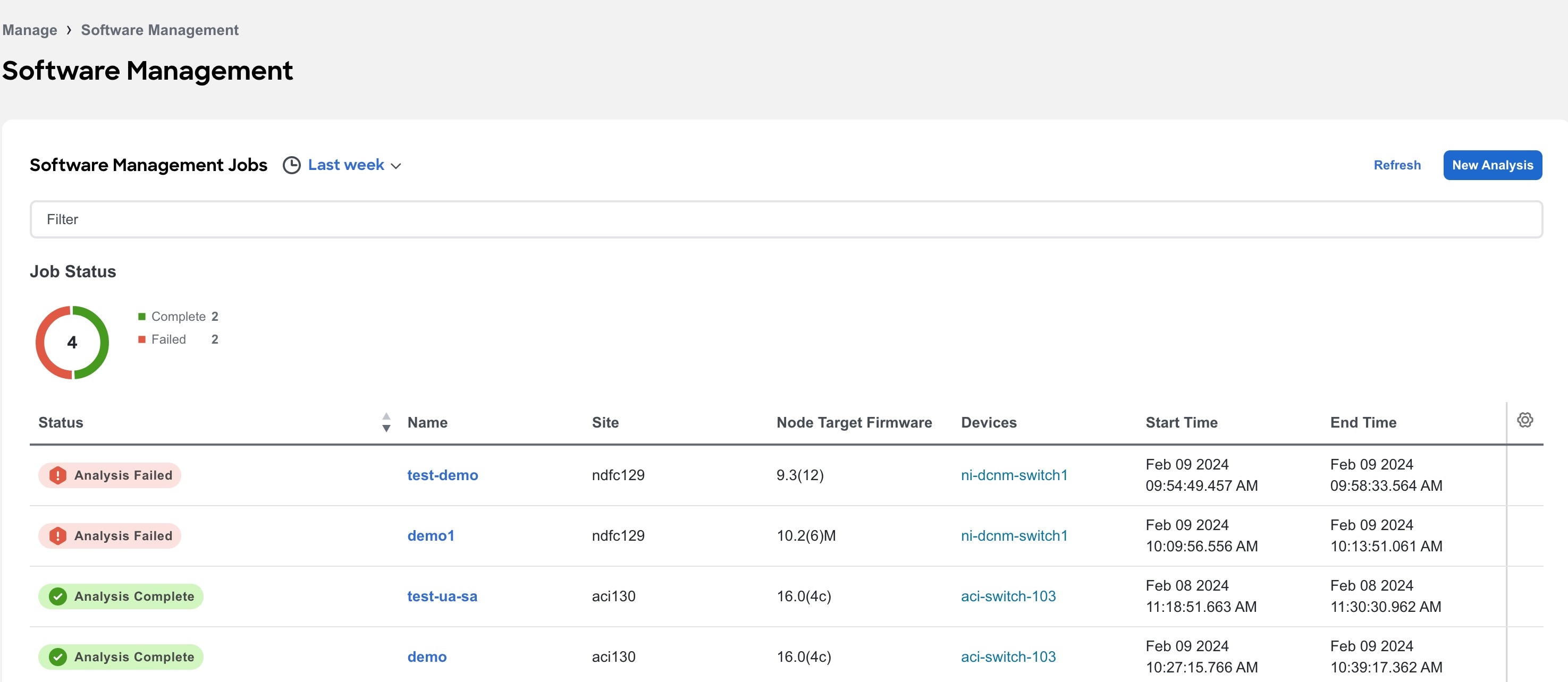
-
Use the Time selector, to select the time range.
-
The Software Management page displays the job status for your sites based on the selected time range.
-
Use the filter bar to filter the jobs by status.
-
The Job Status donut chart displays the number of jobs along with their status.
-
In the Jobs table you view the information for the software management jobs such as status, name, site, node target firmware, devices, start time, end time
-
-
Click the gear icon to configure the columns in the Jobs table.
Create Software Management
-
Choose Manage > Site Software Management > New Analysis.
-
Enter the analysis name.
-
Select a site. Click Next.
-
Select the firmware. Cisco recommended release and the latest firmware release are displayed.
-
Click Select Nodes.
-
Select the nodes. Only the nodes that are required to be updated are displayed. You can only select 10 nodes at a time per analysis.
-
Click Add.
-
-
Click Create Job. The job is displayed in the Software Management Dashboard.
-
Click a completed analysis to view the details.
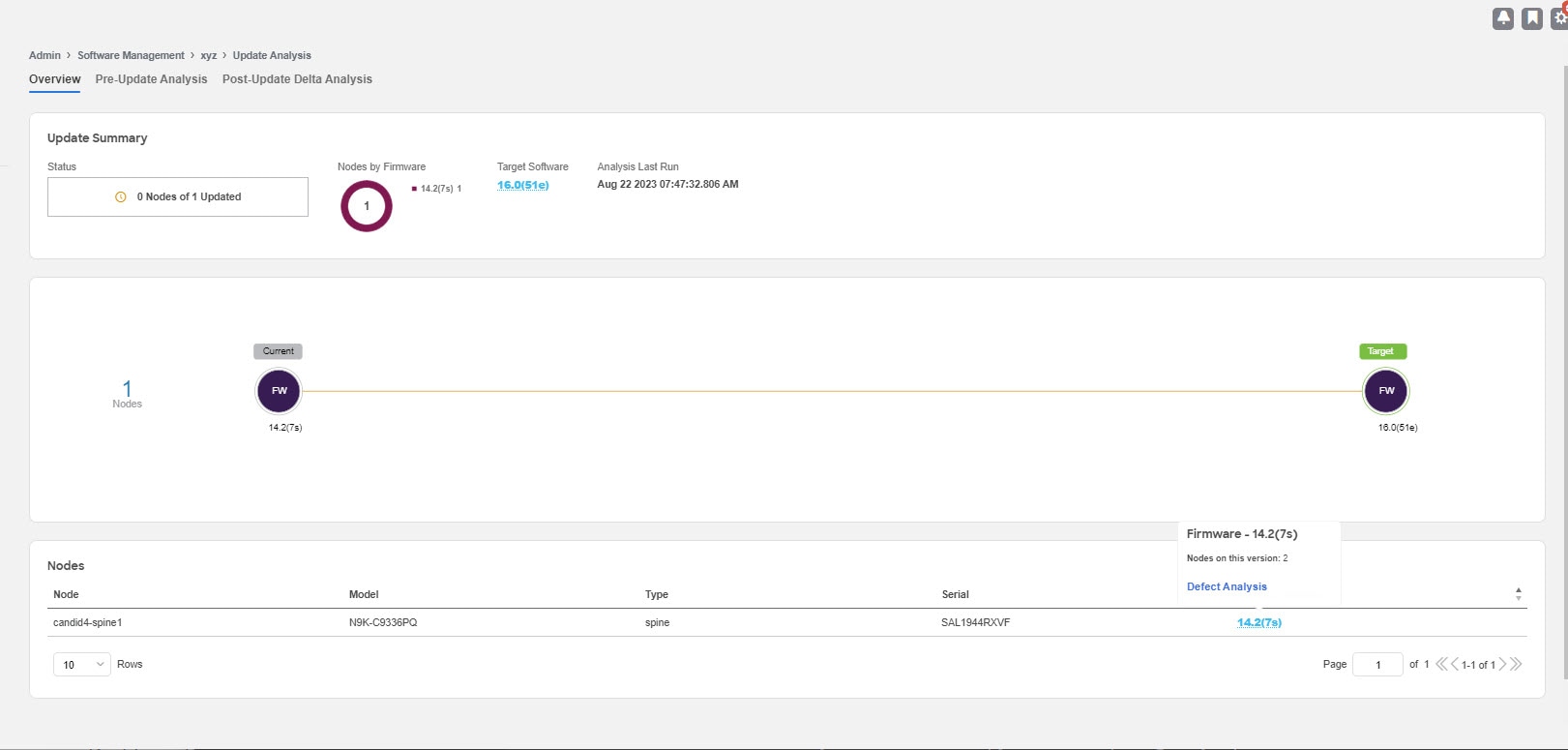
Analysis Detail
-
General - This shows if the analysis status
-
Firmware summary - This shows site, site firmware, site target firmware, selected nodes, node firmware and node target firmware
-
Upgrade path for the firmware and node. The upgrade path for firmware and node is displayed separately if the firmware is selected.
Click View Update Details to view the pre-update analysis and post update analysis for the firmware or node.
Overview
This displays the update summary, the upgrade path and the list of nodes in a tabular form.
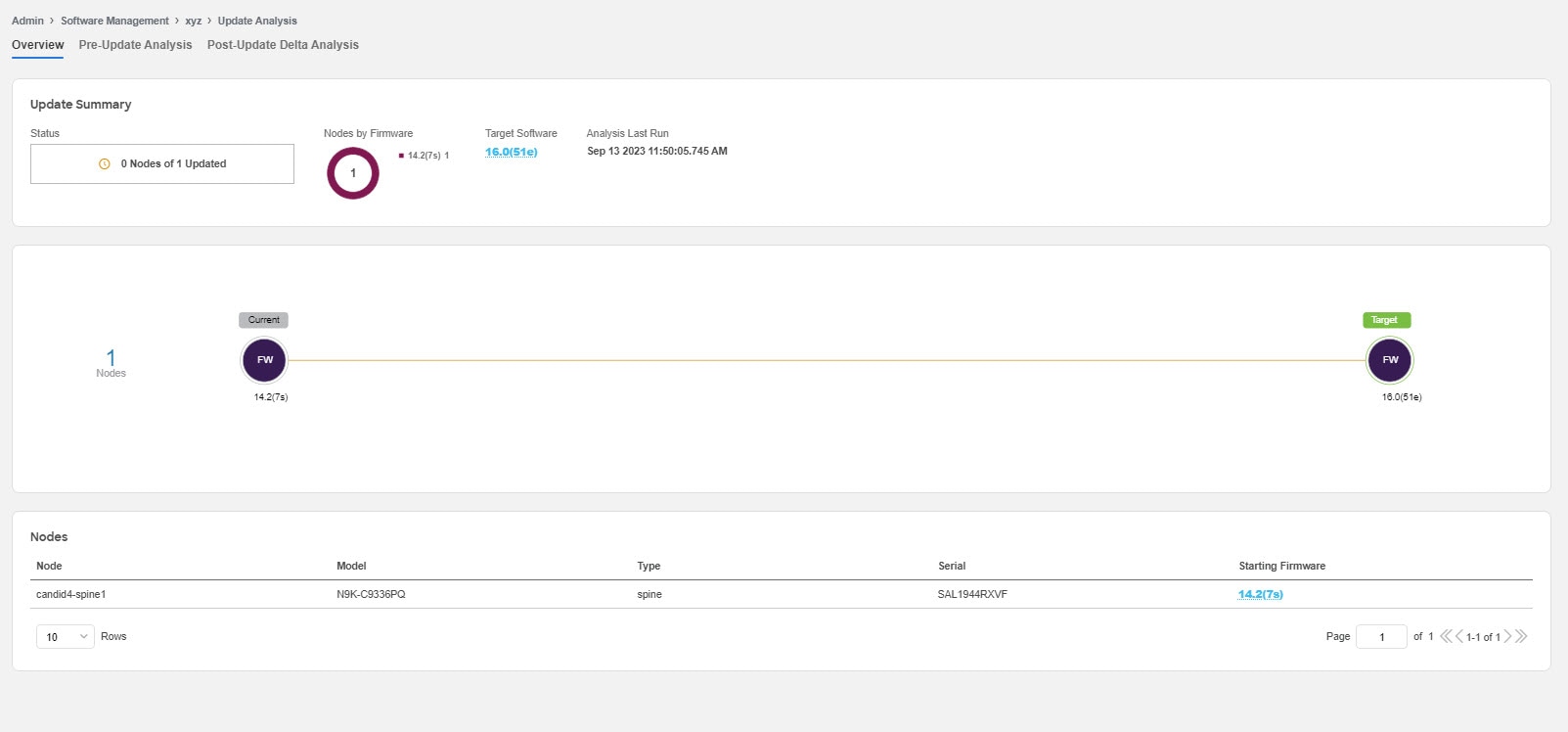
Pre-Update Analysis
This displays details such as node status, validation results, potential affected objects, forecasted clear alerts after the upgrade, and potential release defects applicable after the upgrade. This also shows the anomaly and advisory forecast. After fixing any of the issues highlighted in the Validation Results area, click Rerun Analysis. Click the drop down button to view pre-update validation criteria and the issues detected for each criteria. See Pre-Validation Criteria for Cisco APIC.
We recommend you to run the python script again, upload the file and then run the assurance analysis again to check if the changes had effect on the pre-upgrade validation.
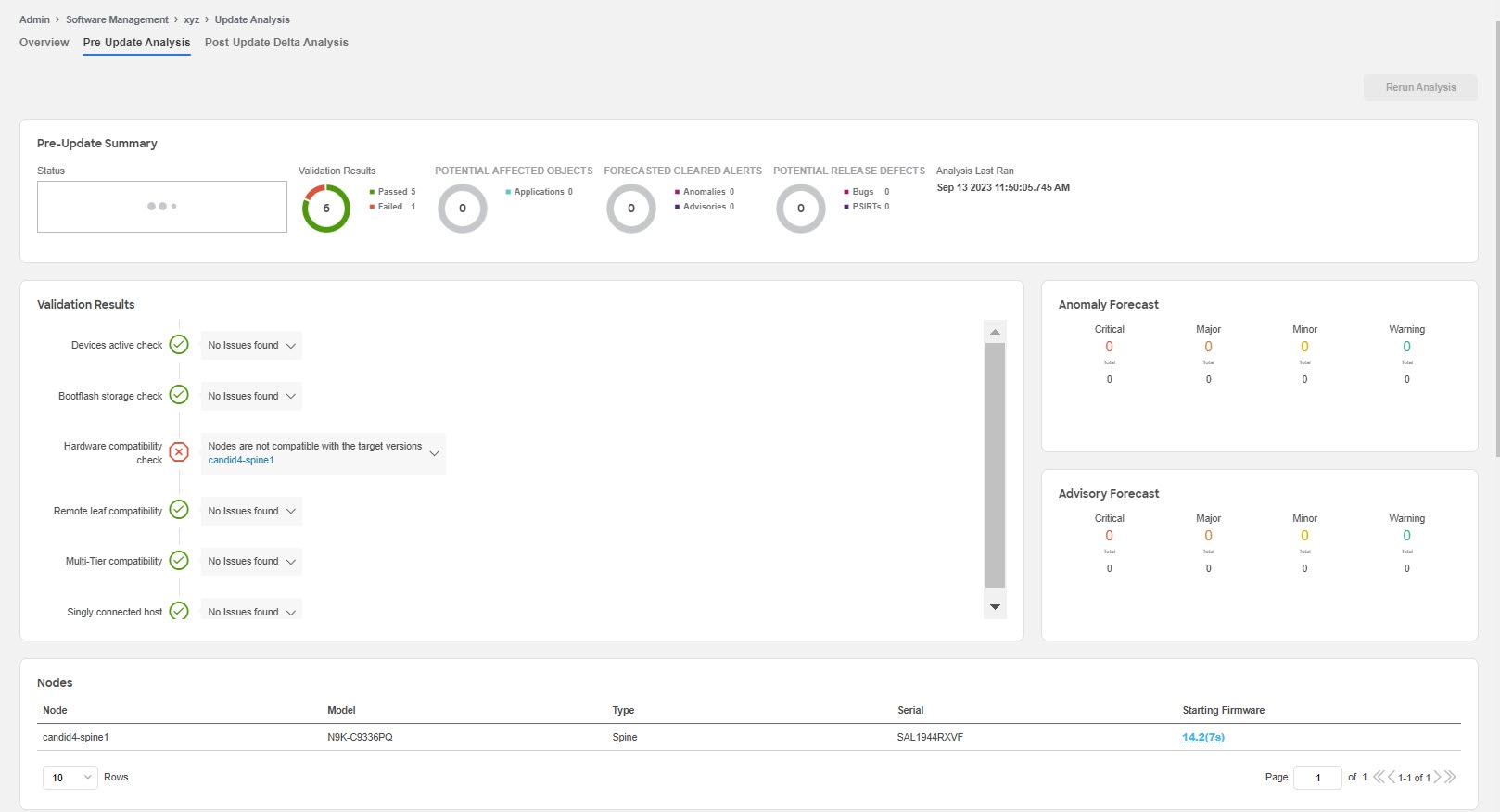
Post-Update Analysis
This displays the post-update analysis details. The post-update summary displays the status of the upgrade.
-
Click Health Delta to view the difference in the anomalies between the pre-upgrade and post-upgrade analysis.
-
Click Operational Delta to view the difference in the operational resources between the pre-upgrade and post-upgrade analysis.
-
Click Policy Delta to view the difference in the polices between when the pre-upgrade and post-upgrade analysis were run. This is applicable only for ACI sites.
-
Click Rerun Analysis.
View Active and Susceptible Bugs
Ensure that Bug Scan is enabled for all sites.
-
Navigate to Manage > Site Software Management.
-
In the Software Management Jobs table click an analysis.
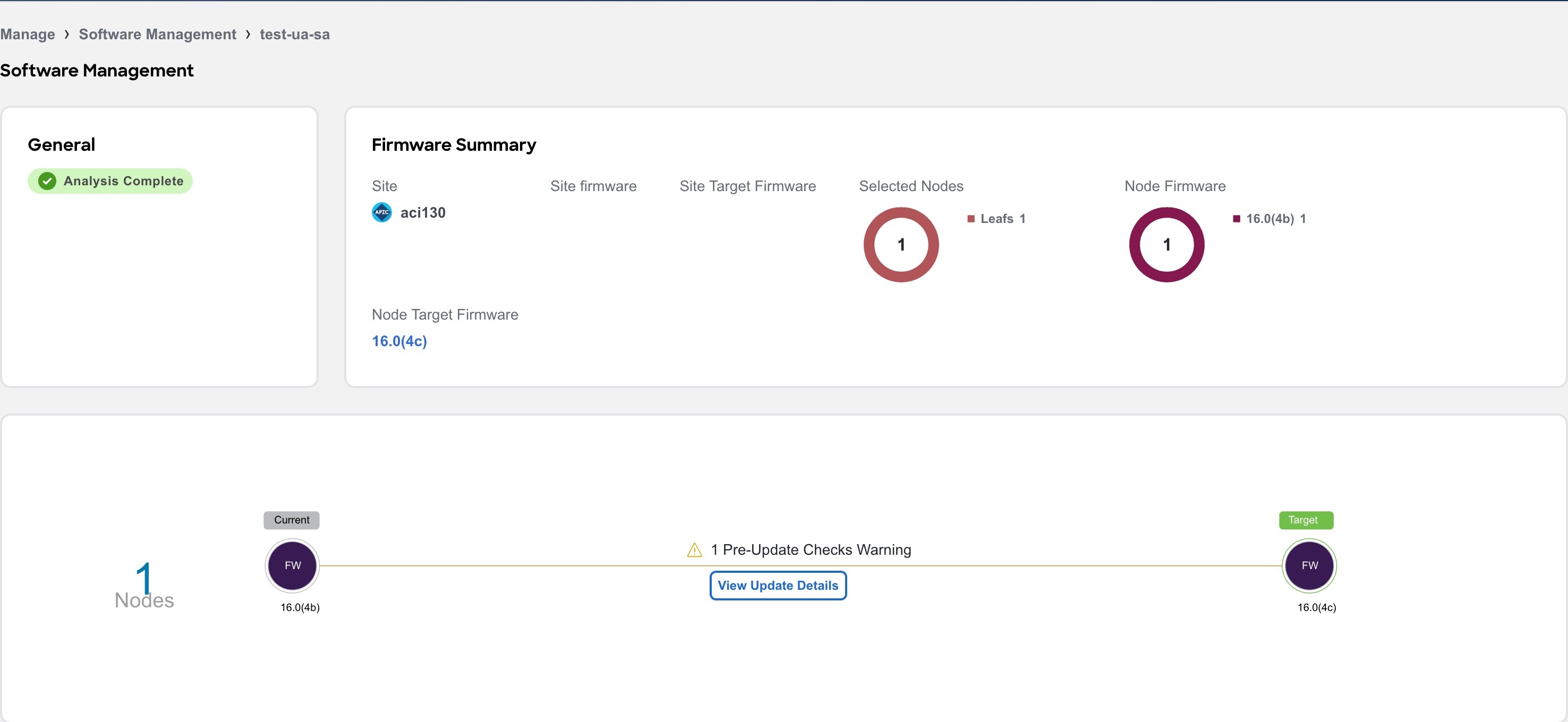
In the Firmware Summary area, hover on the Node Target Firmware and click View Bugs to view the active and susceptible bugs for that particular software version on that site. See Bug Scan.
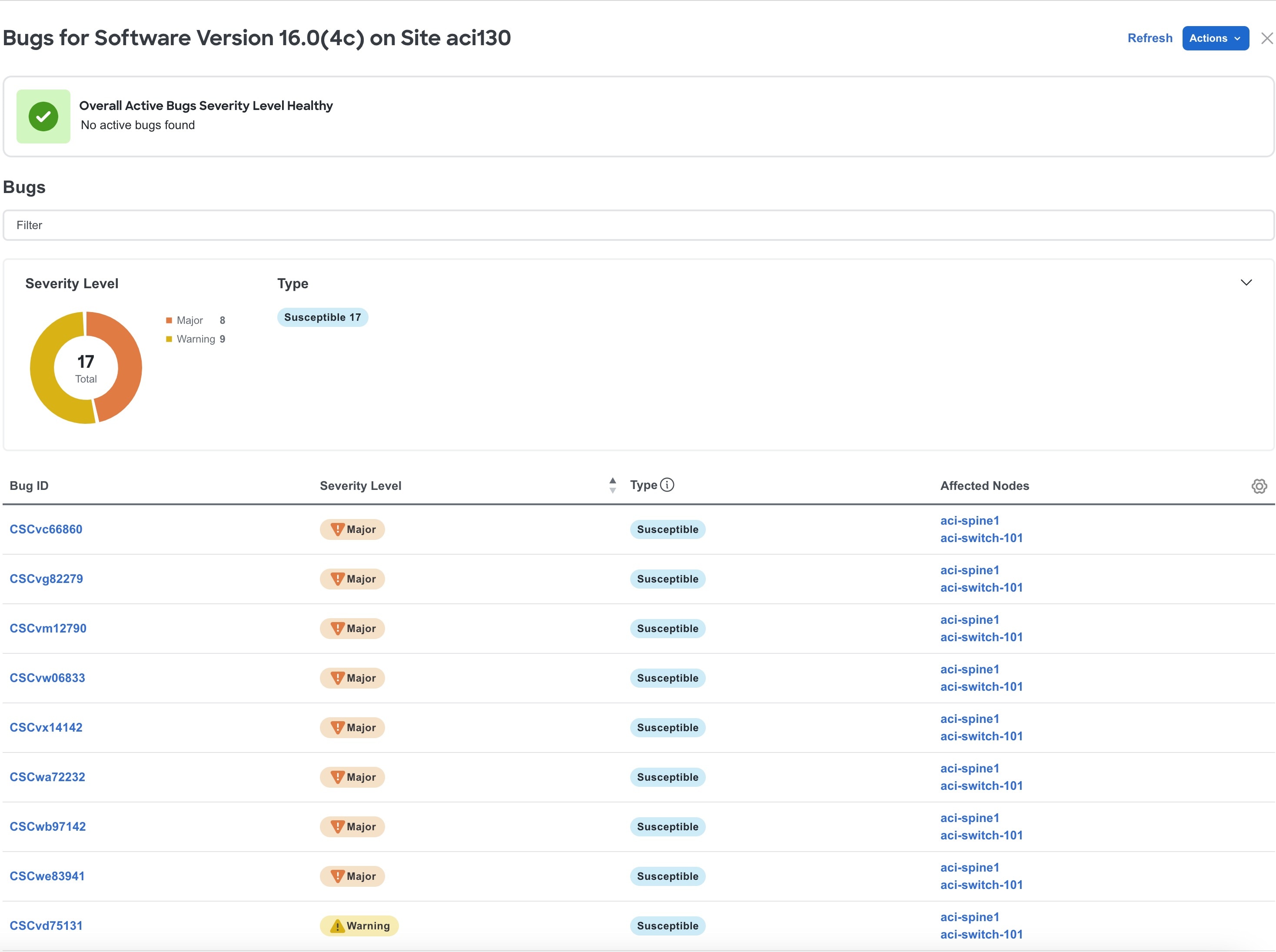
-
From the Actions dropdown menu click Run Bug Scan to run an on-demand Bug Scan.
Pre-Validation Criteria for Cisco APIC
| Pre-Validation Criteria | Description | Release |
|---|---|---|
|
Found inactive devices |
This validation checks if all devices are active. |
6.0.1 |
|
Select a compatible target version |
This validation checks if the target firmware version is compatible with the current running version. |
6.0.1 |
|
Remote leaf compatibility |
This validation checks if remote leaf feature is supported in the target firmware version and if the fabric is using remote leaf feature. |
6.0.1 |
|
Multi-Tier compatibility |
This validation check if Multi-Tier topology is supported in the target firmware version and if the fabric has Tier-2 leaf nodes. |
6.0.1 |
|
The fabric has 4 active critical configuration faults |
This validation checks the presence of critical configuration faults or specific faults that may impact the firmware update. |
6.0.1 |
|
Pod(s) have fewer than two route reflectors for infra MP-BGP |
This validation checks if each pod has at least two spine nodes configured as route reflectors for infra MP-BGP. |
6.0.1 |
|
Nodes are not in vPC |
This validation checks if leaf nodes are configured with vPC to ensure the redundancy/high availability during the firmware update. |
6.0.1 |
|
Nodes do not have out-of-band management IP |
This validation checks the presence of nodes without OOB (Out-of-Band) management IP configuration to ensure that you always have access to all nodes. |
6.0.1 |
|
NTP is not configured |
This validation checks if Network Time Protocol (NTP) is configured for Cisco APICs. |
6.0.1 |
|
Switch upgrade maintenance group check |
This validation checks if APICs have maintenance and firmware groups. |
6.0.1 |
|
Failed to validate rule |
This validation checks if the target firmware version is compatible with current running CIMC versions. |
6.0.1 |
|
Cisco APICs in cluster have different infra VLAN IDs |
This validation checks if APICs in the cluster have same infra VLAN IDs |
6.0.1 |
|
Cisco APIC cluster status is not fully-fit for all APIC nodes |
This validation checks if the APIC cluster status is fully-fit for all APIC nodes. |
6.0.1 |
|
Fabric recovery is in progress |
This validation checks if there is any fabric recovery in progress. |
6.0.1 |
|
The configured SNMPv3 user authorization and/or privacy types are not supported in the target Cisco APIC firmware version |
This validation checks if configured SNMPv3 user authorization and/or privacy types are supported in the target APIC firmware version. |
6.0.1 |
|
Endpoint network redundancy |
This validation checks if nodes have non-redundant endpoints to avoid traffic loss during the reboot of nodes. |
6.0.2 |
|
APIC Cluster Status |
This validation checks if the APIC cluster status is fully-fit for all APIC nodes. If it is data-layer-partially-diverged or anything other than fully-fit, firmware update for APICs and switches should not be performed. |
6.3.1 |
|
APIC Cluster Status |
This validation checks if the APIC cluster status is fully-fit for all APIC nodes. If it is data-layer-partially-diverged or anything other than fully-fit, firmware update for APICs and switches should not be performed. |
6.3.1 |
|
APIC Disk Space |
This validation checks if there are any faults warning that an APIC is running low on disk space. This could cause the APIC upgrade to fail. APICs raise three different faults depending on the amount of disk space remaining. If any of these faults are raised on the system, the issue should be resolved prior to performing the upgrade. |
6.3.1 |
|
Switch Bootflash Usage |
This validation checks if there is enough bootflash storage to successfully upgrade a switch node. |
6.3.1 |
|
APIC SSD Health |
This validation checks if there are any faults warning the APIC SSD health status. |
6.3.1 |
|
Switch SSD Health |
This validation checks if there are any faults warning the Switch SSD health status. |
6.3.1 |
|
Daily Configuration Backup |
This validation checks if there is a valid configuration backup taken in the last 24 hours. |
6.3.1 |
|
NTP Configuration |
This validation checks if Network Time Protocol (NTP) is configured for APICs. |
6.3.1 |
|
NTP Status |
This validation checks if Network Time Protocol (NTP) is Synced on APICs and Switches in the Fabric. |
6.3.1 |
|
OOB management IP |
This validation checks the presence of nodes without OOB (Out-of-Band) management IP configuration to ensure that you always have access to all nodes. During the upgrade/downgrade, nodes may not be reachable via ACI infra. It is recommended to prepare console access to each node as well just in case. |
6.3.1 |
|
Ongoing Fabric Recovery |
This validation checks if there is any fabric recovery in progress. |
6.3.1 |
|
Active Apps |
This validation checks if there are any active apps in the APIC that need to be disabled. |
6.3.1 |
|
Configuration Zones |
This validation checks if there are any configuration zones that need to be disabled or removed prior to the upgrade. |
6.3.1 |
|
Switch High Availability (vPC Leafs) |
This validation checks if leaf nodes are configured with vPC to ensure the redundancy/high availability during the firmware update. If the fabric provides redundancy via other means such as ECMP, or has single-homed servers on purpose, ignore this check. |
6.3.1 |
|
Switch High Availability (Spine Route Reflectors) |
This validation checks if each pod has at least two spine nodes configured as route reflectors for infra MP-BGP. If all route reflector spine nodes are unavailable at the same time, the fabric will lose the reachability to external routes from L3Outs. |
6.3.1 |
|
Upgrade Group (Spine HA) |
If any maintenance groups are found, this validation checks for 1) Not all spines in the same pod are upgraded in the same group. 2) Not all BGP Route Reflector spines are upgraded in the same group. 3) Not all IPN/ISN spines are upgraded in the same group. |
6.3.1 |
|
Upgrade Group (vPC HA) |
This validation checks that both leaf nodes of the same vPC pair are not in the same upgrade group. |
6.3.1 |
|
Upgrade Group (APIC Leaf HA) |
This checks that both leaf nodes connected to the same APIC do not belong to the same upgrade group. |
6.3.1 |
|
Critical Configuration Faults |
This validation checks the presence of critical config faults or specific faults that may impact the firmware update. |
6.3.1 |
|
Controller Port Configuration Conflict |
This validation checks if there are any faults warning that there is configuration being rejected because it’s deployed on an APIC connected port. |
6.3.1 |
|
L3 Interface Deployment Conflict |
This validation checks if there are any faults warning that L3 configuration is being rejected on a port already operating in L2 mode. |
6.3.1 |
|
L2 Interface Deployment Conflict |
This validation checks if there are any faults warning that L2 configuration is being rejected on a port already operating in L3 mode. |
6.3.1 |
|
Overlapping BD Subnets |
This validation checks if there are any faults warning that BD subnets are not the same but overlapping in the same VRF. Only one of those configurations takes effect at a given time. Hence, after the upgrade, a different BD subnet than before may take effect. |
6.3.1 |
|
Duplicated BD Subnets |
This validation checks if there are any faults warning that external Bridge Domains in the same VRF have overlapping prefixes. |
6.3.1 |
|
External EPG Prefix Overlap |
This validation checks if there are any faults warning that external EPGs in the same VRF have overlapping prefixes. |
6.3.1 |
|
HW Programming Failure (L3Out Prefixes, Contracts) |
This validation checks if there are any faults warning that L3Out prefix to pcTag mapping entries or contracts are failed to be programmed. |
6.3.1 |
|
Scalability (Faults Related to Capacity Dashboard) |
This validation checks if there are any stats faults (TCA: Threshold Crossing Alert) related to object eqptcapacityEntity warning scalability issues that can be checked via Capacity Dashboard in the APIC GUI. By default, not all stats in Capacity Dashboard are configured with thresholds to raise a fault. This can be checked and configured under Fabric > Fabric Policies > Policies > Monitoring > default > Stats Collection Policies > Monitoring Object > Equipment Capacity Entity (eqptcapacityEntity) > Stats Type. |
6.3.1 |
|
Overlapping VLAN Pools |
This detects VLAN pools with overlapping VLAN IDs on the same EPG. Such configuration may cause traffic impact after or during an upgrade unless this configuration is intentional and you are familiar with how VNIDs are assigned and work in ACI. |
6.3.1 |
|
ISIS Redistribution Metric for Multi-Pod/Multi-Site |
This checks ISIS redistribution metrics for multi-pod and multi-site. |
6.3.1 |
|
L3Out MTU Size |
This validation checks the MTU size configured on all Layer 3 Outs in the Fabric. If the MTU size on ACI L3Out sides and connected devices does not match, route-exchange after an upgrade may fail even if everything used to work prior to the upgrade. |
6.3.1 |
|
Different Infra VLAN via LLDP |
This validation checks if there are any faults. If you have interfaces connected back-to-back between two different ACI fabrics, you must disable LLDP on those interfaces prior to upgrades. This is because when the switch comes back up after the upgrade, it may receive and process LLDP packets from the other fabric that may be using a different infra VLAN. If that happens, the switch incorrectly tries to be discovered through the infra VLAN of the other fabric and will not be discoverable in the correct fabric. |
6.3.1 |
|
Offline VMM Domain |
This validation checks if any VMM Domains have controllers which are offline. |
6.3.1 |
|
VMM Domain LLDP/CDP Adjacency |
This validation checks if there are any faults warning when APIC cannot find LLDP/CDP information of vSwitch through vCenter for VMM DVS integration. The LLDP/CDP information is used to detect which interfaces of ACI switches to deploy VLANs dynamically. |
6.3.1 |
|
CIMC compatibility |
This validation checks if the target firmware version is compatible with current running CIMC versions. |
6.3.1 |
|
Version compatibility |
This validation checks if the target firmware version is compatible with the current running version. |
6.3.1 |
|
Remote leaf compatibility |
This validation checks if remote leaf feature is supported in the target firmware version if the fabric is using remote leaf feature. This check is mainly for downgrade scenario. |
6.3.1 |
|
Multi-Tier compatibility |
This validation check if Multi-Tier topology is supported in the target firmware version if the fabric has Tier-2 leaf nodes. This check is mainly for downgrade scenario. |
6.3.1 |
|
Switch upgrade maintenance group check |
This validation checks if APICs have Maintenance and Firmware groups exists before upgrade from pre-4.0 to 4.0 or later releases. |
6.3.1 |
|
Infra VLAN ID check |
This validation checks if APICs in the cluster have same infra VLAN IDs. |
6.3.1 |
|
SNMPv3 auth compatibility |
This validation checks if configured SNMPv3 user authorization and/or privacy types are supported in the target APIC firmware version. |
6.3.1 |
Copyright
THE SPECIFICATIONS AND INFORMATION REGARDING THE PRODUCTS IN THIS MANUAL ARE SUBJECT TO CHANGE WITHOUT NOTICE. ALL STATEMENTS, INFORMATION, AND RECOMMENDATIONS IN THIS MANUAL ARE BELIEVED TO BE ACCURATE BUT ARE PRESENTED WITHOUT WARRANTY OF ANY KIND, EXPRESS OR IMPLIED. USERS MUST TAKE FULL RESPONSIBILITY FOR THEIR APPLICATION OF ANY PRODUCTS.
THE SOFTWARE LICENSE AND LIMITED WARRANTY FOR THE ACCOMPANYING PRODUCT ARE SET FORTH IN THE INFORMATION PACKET THAT SHIPPED WITH THE PRODUCT AND ARE INCORPORATED HEREIN BY THIS REFERENCE. IF YOU ARE UNABLE TO LOCATE THE SOFTWARE LICENSE OR LIMITED WARRANTY, CONTACT YOUR CISCO REPRESENTATIVE FOR A COPY.
The Cisco implementation of TCP header compression is an adaptation of a program developed by the University of California, Berkeley (UCB) as part of UCB’s public domain version of the UNIX operating system. All rights reserved. Copyright © 1981, Regents of the University of California.
NOTWITHSTANDING ANY OTHER WARRANTY HEREIN, ALL DOCUMENT FILES AND SOFTWARE OF THESE SUPPLIERS ARE PROVIDED “AS IS" WITH ALL FAULTS. CISCO AND THE ABOVE-NAMED SUPPLIERS DISCLAIM ALL WARRANTIES, EXPRESSED OR IMPLIED, INCLUDING, WITHOUT LIMITATION, THOSE OF MERCHANTABILITY, FITNESS FOR A PARTICULAR PURPOSE AND NONINFRINGEMENT OR ARISING FROM A COURSE OF DEALING, USAGE, OR TRADE PRACTICE.
IN NO EVENT SHALL CISCO OR ITS SUPPLIERS BE LIABLE FOR ANY INDIRECT, SPECIAL, CONSEQUENTIAL, OR INCIDENTAL DAMAGES, INCLUDING, WITHOUT LIMITATION, LOST PROFITS OR LOSS OR DAMAGE TO DATA ARISING OUT OF THE USE OR INABILITY TO USE THIS MANUAL, EVEN IF CISCO OR ITS SUPPLIERS HAVE BEEN ADVISED OF THE POSSIBILITY OF SUCH DAMAGES.
Any Internet Protocol (IP) addresses and phone numbers used in this document are not intended to be actual addresses and phone numbers. Any examples, command display output, network topology diagrams, and other figures included in the document are shown for illustrative purposes only. Any use of actual IP addresses or phone numbers in illustrative content is unintentional and coincidental.
The documentation set for this product strives to use bias-free language. For the purposes of this documentation set, bias-free is defined as language that does not imply discrimination based on age, disability, gender, racial identity, ethnic identity, sexual orientation, socioeconomic status, and intersectionality. Exceptions may be present in the documentation due to language that is hardcoded in the user interfaces of the product software, language used based on RFP documentation, or language that is used by a referenced third-party product.
Cisco and the Cisco logo are trademarks or registered trademarks of Cisco and/or its affiliates in the U.S. and other countries. To view a list of Cisco trademarks, go to this URL: http://www.cisco.com/go/trademarks. Third-party trademarks mentioned are the property of their respective owners. The use of the word partner does not imply a partnership relationship between Cisco and any other company. (1110R)
© 2017-2024 Cisco Systems, Inc. All rights reserved.